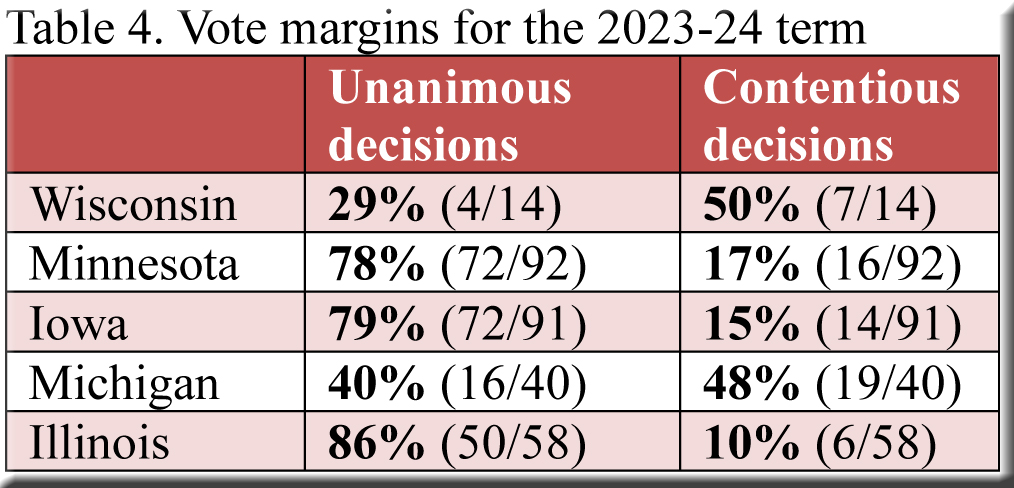Last week’s post examined four aspects of decisions from the supreme courts of Wisconsin, Minnesota, and Iowa: (1) the number of decisions filed in 2023-24; (2) the length of these decisions; (3) the number of separate opinions; and (4) the distribution of vote margins. Today, we’ll see how the supreme courts of Wisconsin’s other two neighbors compare in these regards.
Michigan
When Michigan joins the study, all four indicators place its supreme court in an intermediate position for the 2023-24 term—flanked by Wisconsin’s supreme court on the one hand and those of Minnesota and Iowa on the other. This was not always the case in preceding terms. For instance, a post covering 2016-17 to 2018-19 found Wisconsin averaging 55 decisions per term, Minnesota 90, Iowa 92, and Michigan only 29. Perhaps 2023-24 will come to seem an outlier, but for now Michigan resides squarely between Wisconsin and the other two states throughout the five categories in Tables 1 and 2.[1]
Illinois
All the columns in Tables 3 and 4 situate Illinois closer—often much closer—to the results for Minnesota and Iowa than those for Wisconsin and even Michigan.[2] Overall, then, Minnesota and Iowa remain nearly identical across the board, with Wisconsin either far above or far below all its neighbors in every category except “contentious decisions,” where the gap with Michigan is negligible.[3] The Illinois Supreme Court stands out most distinctly among its counterparts with an extremely low frequency of separate opinions and a very high percentage of unanimous decisions—an inverse relationship similar to Wisconsin’s torrent of separate opinions and dearth of unanimity.
[1] As noted in the previous post, the number of decisions does not include orders involving (1) disciplinary matters, (2) various petitions and motions, (3) cases where the court decided that review had been improvidently granted, and (4) deadlocked (3-3) per curiam decisions. Other per curiam decisions are included: one for Wisconsin, four for Minnesota, none for Iowa, two for Michigan, and none for Illinois. I am excluding (a) six Iowa cases that generated very short per curiam decisions (no more than two pages) along with notes that these decisions were not designated for publication, (b) a Michigan case, O’Halloran v. Secretary of State, which was decided after the end of the court’s 2023-24 term, and (c) an Illinois case, Collazo v. Illinois State Board of Elections, which was dismissed in a one-paragraph per curiam decision because it was “not possible to secure the constitutionally required concurrence of four judges for a decision.”
Per curiam decisions are excluded in the “Wisconsin-equivalent pages per decision” and “Average number of separate opinions per decision” columns.
See the previous post for an explanation of the figures in the “Wisconsin-equivalent pages per decision” column.
[2] Illinois is closer to Michigan than to Minnesota and Iowa in the “Number of decisions” column but not in any of the other four columns.
[3] “Contentious decisions” are those decided by 5-2 or 4-3 votes.




Speak Your Mind